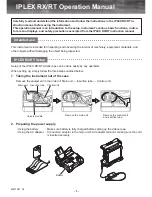
6
Operating Instructions and Parts Manual
24383
VIDEO BORESCOPE
11/16
2016 OEMTOOLS
®
5.
DO NOT use the imager head and cable to move
items, clear pathways or clogged areas.
6.
DO NOT eat or smoke while operating the Video
Borescope. Use hot, soapy water to wash hands
and other body parts exposed to drain contents
after using the Video Borescope to inspect drains
and other areas that may contain chemicals or
bacteria, which will help prevent contamination
with toxic or infectious material.
7. When the inspection is completed, carefully
withdraw the imager head and cable from the
inspection area, and take out the 4 AA dry
batteries.
8. Maintain the Video Borescope with care. A
properly maintained Video Borescope is less likely
to cause injury.
9.
DO NOT drop the Video Borescope. If the Video
Borescope is dropped accidently, check for damage
and any other condition that may affect its operation.
10. Dry your hands before operating the Video
Borescope.
11. Use appropriate personal protective equipment
while handling and using the Video Borescope.
Appropriate personal protective equipment
always includes safety glasses and gloves, and
may include latex or rubber gloves, face shields,
goggles, protective clothing, respirators and steel
toed footwear.
12. Protect against excessive heat. Keep the Video
Borescope away from heat sources such as
radiators, stoves or others that produce heat.
Do not use the Video Borescope near moving
machinery or areas where the temperature will
exceed 113°F.
13. Store the Video Borescope and all cables in
a locked area out of the reach of children and
people unfamiliar with Video Borescope.
MAINTENANCE
1. Make sure the power is OFF.
2. Clean any oil, grease or dirt from the Video
Borescope, especially on the buttons and ports.
This helps prevent the Video Borescope from
slipping from your hands.
3. Inspect the imager head lens for condensation. To
avoid damaging the Video Borescope, do not use
the Video Borescope if condensation forms inside
the imager head. Let the water evaporate before
using again.
4. Inspect the full length of the cable for cracks or
damage. A damaged cable could allow water to
enter the Video Borescope and increase the risk
of electric shock.
5. Make sure the connections between the display
unit and imager head and cable are tight. All
connections must be properly assembled for the
cable to be waterproof.
6. Check if the warning label is present, firmly
attached and readable. Do not operate the Video
Borescope without the caution label.
7. Turn on the power and make sure the splash
screen and then the live screen are displayed.
8. If the Video Borescope does not work properly
after being turned on, please have the Video
Borescope checked by a qualified technician.
Any Video Borescope that cannot be controlled
with the power button is dangerous and must be
repaired.
9. Always store the Video Borescope in a well-
protected area where it will not be exposed to
inclement weather, corrosive vapors, abrasive
dust, or any other harmful elements.
10. When maintaining, use only identical replacement
parts. Use of unauthorized parts or failure to
follow maintenance instructions may create a risk
of electric shock or injury.
11.
DO NOT use acetone to clean the Video
Borescope. Instead, use an alcohol swab. Avoid
rubbing too hard on the LCD screen. After using,
wipe the display unit clean gently with a dry cloth.
12.
DO NOT disassemble the tool beyond what is
shown in the manual. Doing so will void your
warranty.


























